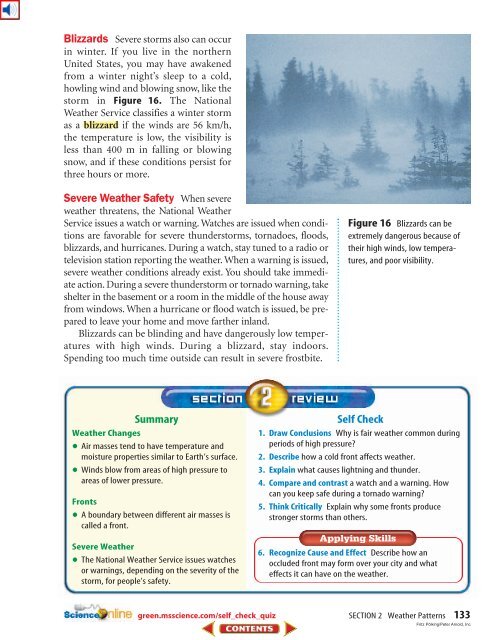Chapter 5: Weather
Chapter 5: Weather
Chapter 5: Weather
Create successful ePaper yourself
Turn your PDF publications into a flip-book with our unique Google optimized e-Paper software.
Blizzards Severe storms also can occur<br />
in winter. If you live in the northern<br />
United States, you may have awakened<br />
from a winter night’s sleep to a cold,<br />
howling wind and blowing snow, like the<br />
storm in Figure 16. The National<br />
<strong>Weather</strong> Service classifies a winter storm<br />
as a blizzard if the winds are 56 km/h,<br />
the temperature is low, the visibility is<br />
less than 400 m in falling or blowing<br />
snow, and if these conditions persist for<br />
three hours or more.<br />
Severe <strong>Weather</strong> Safety When severe<br />
weather threatens, the National <strong>Weather</strong><br />
Service issues a watch or warning. Watches are issued when conditions<br />
are favorable for severe thunderstorms, tornadoes, floods,<br />
blizzards, and hurricanes. During a watch, stay tuned to a radio or<br />
television station reporting the weather. When a warning is issued,<br />
severe weather conditions already exist. You should take immediate<br />
action. During a severe thunderstorm or tornado warning, take<br />
shelter in the basement or a room in the middle of the house away<br />
from windows. When a hurricane or flood watch is issued, be prepared<br />
to leave your home and move farther inland.<br />
Blizzards can be blinding and have dangerously low temperatures<br />
with high winds. During a blizzard, stay indoors.<br />
Spending too much time outside can result in severe frostbite.<br />
Summary<br />
<strong>Weather</strong> Changes<br />
• Air<br />
• Winds<br />
masses tend to have temperature and<br />
moisture properties similar to Earth’s surface.<br />
blow from areas of high pressure to<br />
areas of lower pressure.<br />
•Fronts<br />
A boundary between different air masses is<br />
called a front.<br />
•Severe <strong>Weather</strong><br />
The National <strong>Weather</strong> Service issues watches<br />
or warnings, depending on the severity of the<br />
storm, for people’s safety.<br />
green.msscience.com/self_check_quiz<br />
Figure 16 Blizzards can be<br />
extremely dangerous because of<br />
their high winds, low temperatures,<br />
and poor visibility.<br />
Self Check<br />
1. Draw Conclusions Why is fair weather common during<br />
periods of high pressure?<br />
2. Describe how a cold front affects weather.<br />
3. Explain what causes lightning and thunder.<br />
4. Compare and contrast a watch and a warning. How<br />
can you keep safe during a tornado warning?<br />
5. Think Critically Explain why some fronts produce<br />
stronger storms than others.<br />
6. Recognize Cause and Effect Describe how an<br />
occluded front may form over your city and what<br />
effects it can have on the weather.<br />
SECTION 2 <strong>Weather</strong> Patterns 133<br />
Fritz Pölking/Peter Arnold, Inc

















